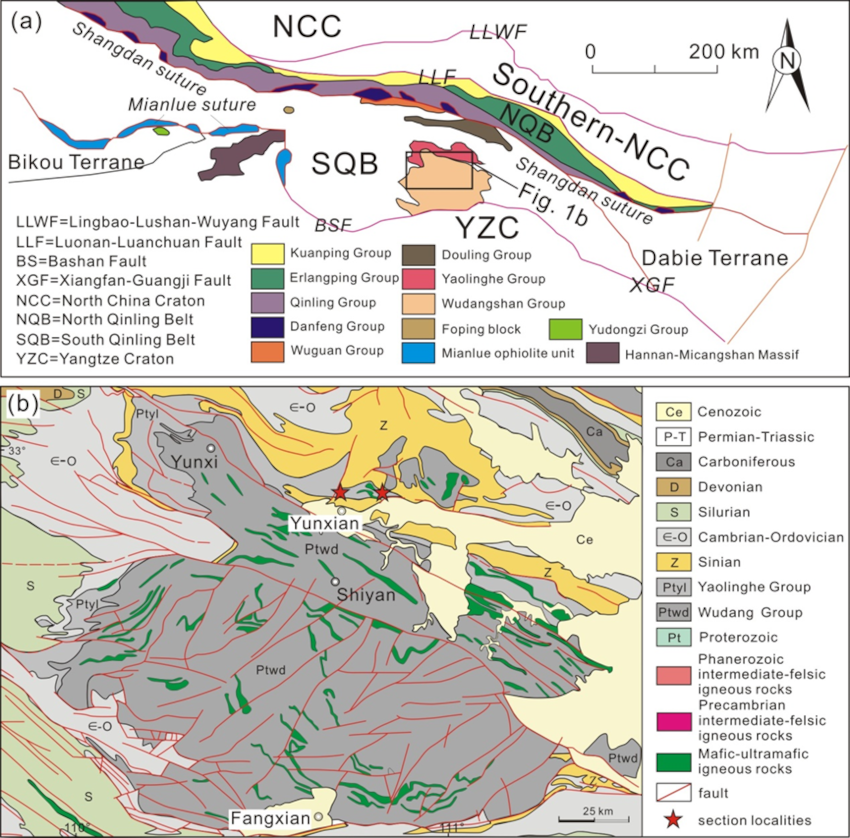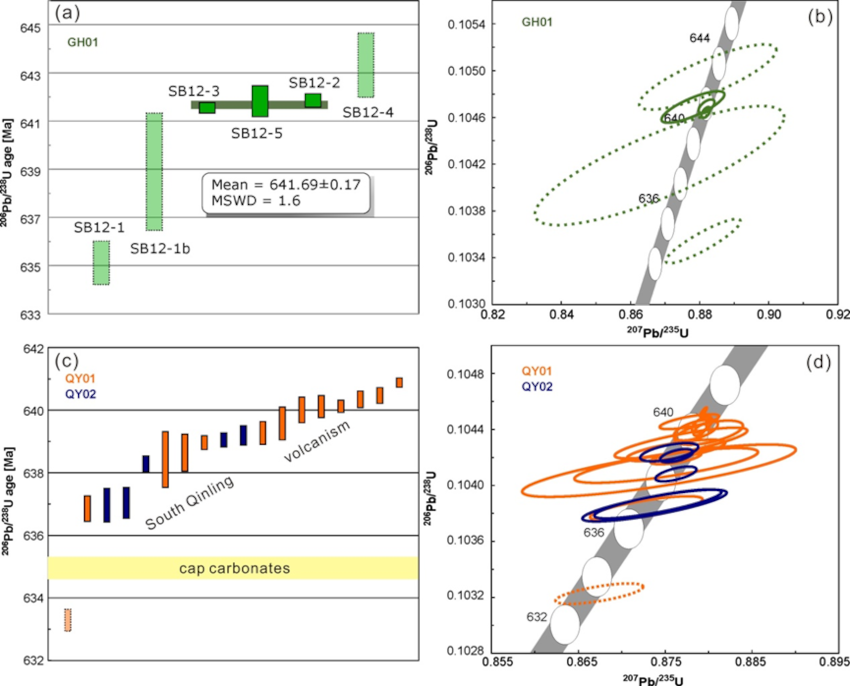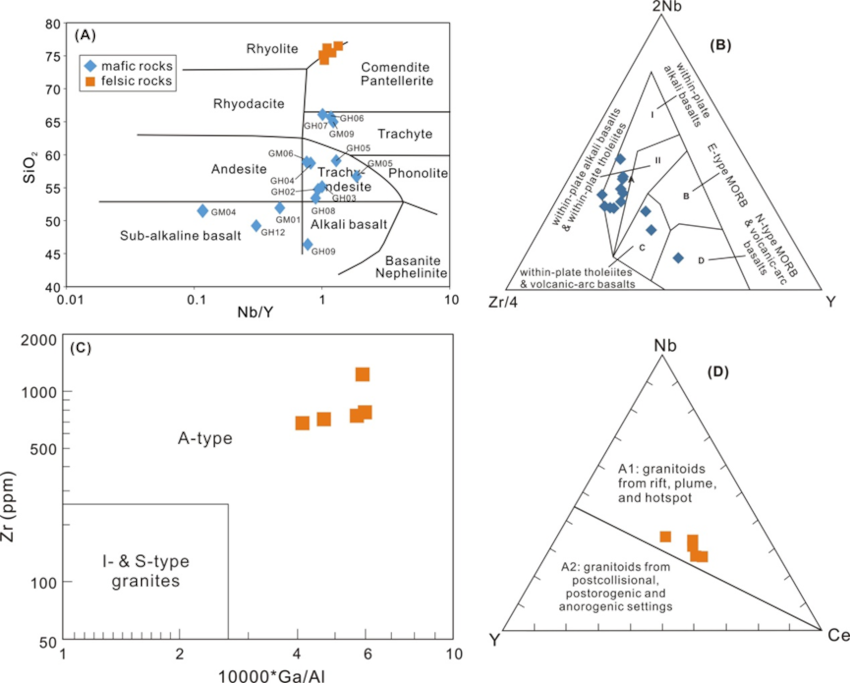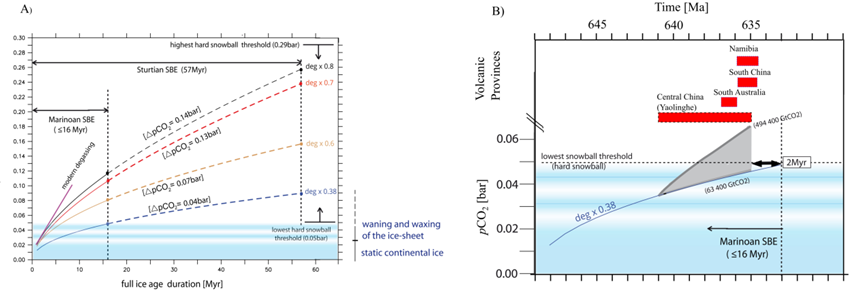May 2022 LIP of the Month
Ca. 641-635 Ma magmatic events in northern South China, and link with the end of the Marinoan glaciation
Zhongwu Lan1,2,3*, Magdalena H. Huyskens4, Guillaume Le Hir5, Ross N. Mitchell1,6, Qing-Zhu Yin4, Gangyang Zhang7, and Xian-Hua Li1,6
1State Key Laboratory of Lithospheric Evolution, Institute of Geology and Geophysics, Chinese Academy of Sciences, Beijing 100029, China. lzw1981@126.com
2State Key Laboratory of Palaeobiology and Stratigraphy, Nanjing Institute of Geology and Palaeontology, Chinese Academy of Sciences, Nanjing 210008, Jiangsu, China.
3State Key Laboratory of Geological Processes and Mineral Resources, China University of Geosciences, Wuhan 430074, Hubei, China.
4Department of Earth and Planetary Sciences, University of California, Davis, CA 95616, USA.
5Institut de Physique du Globe de Paris, Université Paris, 75005 Paris, France.
6College of Earth and Planetary Sciences, University of Chinese Academy of Sciences, Beijing 100049, China.
7College of Earth Sciences, Chengdu University of Technology, Chengdu, Sichuan 610059, China.
Figures compiled from
Lan, Z.W. et al., 2022. Massive volcanism may have foreshortened the Marinoan snowball Earth. Geophysical Research Letters, 49, e2021GL097156. https://doi.org/10.1029/2021GL097156.
Abundant late Cryogenian mafic-felsic volcanic rocks and intrusions and ultramafic intrusions (650-635 Ma) are present in South Qinling to the north of South China Block, with a spatial occurrence of ca. 30,000 km2 (Figure 1). High-precision zircon geochronology with chemical abrasion–isotope-dilution isotope ratio mass spectrometry (CA-ID-IRMS) indicates that this extensive and thick sequence of rift-related magmatic rocks were erupted at 641-637 Ma, which is 2–6 Myr before the termination of the Marinoan glaciation. In combination with volcanism along the northern margin of South China Block that occurred from 637–635 Ma (Condon et al., 2005), new zircon U-Pb age data suggests the emplacement of an igneous province in central China lasted for 6 Myr (641–635 Ma) (Figure 2).
Geochemical analyses including major and trace element and Nd isotope composition analyses were conducted on these volcanic rocks, based on which two main subgroups were recognized including mafic and intermediate (basalts/trachyandesites/trachytes) and felsic (alkaline rhyolites) lithologies (Figure 3a). The basalts, trachyandesites, and trachytes mainly plot in the region of within-plate alkaline basalts in the 2Nb-Zr/4-Y ternary discrimination plot (Figure 3b). The alkaline rhyolites all plot in the anorogenic area in the Zr-10000*Ga/Al and Nb-Y-Ce plots (Figure 3c, d). Most basalts show depletion in Nb-Ta compared to La (i.e., Nb/La<1) and low abundance of Th (0.3–1.6 ppm) in the primitive mantle-normalized trace element spider diagram (Figure 4a), resembling alkali basalts formed in continental rifts. The alkaline rhyolites commonly show enriched trace element distribution patterns except for depletion in Sr and Eu due to fractional crystallization of feldspar (Figure 4b). They mostly display enrichment in Nb-Ta in comparison to La (Nb/La>1).
CO2 emission was estimated from the South Qinling rift. Faulting and fracturing systems offer pathways for CO2 diffusion from the deep crust to the surface in continental extensional tectonics (Hunt et al., 2017). On the basis of an actualistic ad hoc point pattern analysis, magmatism-related CO2 emissions are positively correlative with continental extensional tectonics (Tamburello et al., 2018). CO2 degassing rate has been quantified in continental extensional tectonic regimes as 53,000 kg/km2/yr in the Himalayas, 250,000 kg/km2/yr in central Italy, and 117,000-412,000 kg/km2/yr in the Eastern Ethiopian rift (Tamburello et al., 2018). When applying this degassing rate to the continental rift in the South Qinling region, which has an outcrop area of ~200,000 km2 and spans 6 Myr (641-635 Ma) it would have produced 63,600–494,400 Gt CO2 (Lan et al., 2022).
We do a climate modelling using such an amount of CO2 to see how it could have influenced the Marinoan glaciation. We firstly establish background CO2 degassing before considering the additional CO2 emissions from the South Qinling rift. Background CO2 degassing includes CO2 emissions from continental rifts, volcanic arcs, and mid-ocean ridges. In geological period, such background CO2 degassing would never exceed modern levels, so we use 38% (deg0.38), 60% (deg0.6), 70% (deg0.7), and 80% (deg0.8) of modern levels for the simulations, respectively. With the lowest degassing rate (deg0.38), the melting threshold for the Marinoan glaciation (~0.05 bar) should be twice in comparison to that of the older 720-660 Ma Sturtian glaciation (0.09 bar) (Figure 5a). Considering their different durations, the Sturtian and Marinoan glaciations require different CO2 thresholds to melt. The difference value between the Sturtian/Marinoan thresholds increases with the enhancement of degassing, with the most significant rise plotting between deg0.6 (ΔpCO2~0.07) and deg0.7 (ΔpCO2~0.13) because of the non-linear rate of accumulation. Only a very massive carbon release from the South Qinling rift system and other volcanic provinces could shorten the ice age. Such additional CO2 emissions from the South Qinling rift and its long-lasting volcanic activity could have shortened the Marinoan snowball by 2–5 Myr (Figure 5b).
Aside from the 641-635 Ma magmatism in northern South China, the end of the Marinoan is also typical of active rift-related volcanism in the Australia, Tarim, Siberia, and Congo cratons with an age range of ca. 643–635 Ma (Calver et al., 2013; Condon et al., 2005; Prave et al., 2016; Vernikovsky et al., 1999; Yarmolyuk et al., 2005; Zhu et al., 2008). Within analytical errors, these magmatic events are synchronous with the end-Marinoan magmatism in South Qinling and the northern margin of the Yangtze block (Wang et al., 2013). Of these, near end-Marinoan volcanic provinces were successively emplaced in South Australia (636.4 ± 0.45 Ma; Calver et al., 2013), then South China (635.2 ± 0.57 Ma; Condon et al., 2005) and Namibia (635.2 ± 0.59 Ma; Prave et al., 2016), where these coordinated rift-related volcanic provinces are related to final stages of the breakup of supercontinent Rodinia (Gernon et al., 2016; Mitchell et al., 2019). Considering uncertainties for CO2 and dust emissions, multiple volcanic sources may be considered as a likely scenario, with a dominant source from the South Qinling region. The apparent discrepancy between the end of glaciation (635 Ma) and the prolonged magmatic activity (641–637 Ma) points to cumulative effect of CO2 and dust emissions. Given all these volcanic activities occur in a rift setting their link with the Marinoan glaciation is likely, and further study is needed on these Marinoan-related LIPs.

Figure 1. Tectonic and geologic map of the study area. (a) Internal divisions of the Qinling orogen and its tectonic relationships with the North China craton and the Yangtze block (modified from (Hu et al., 2016)). (b) Simplified geologic map of the Wudang area in the South Qinling terrane (modified from Wang et al. (2016)).

Figure 2. Zircon CA-ID-IRMS U-Pb ages. (a) U-Pb ages from tuffaceous breccia sample GH01, also shown as a Concordia diagram in (b). After rejecting two dates from one split grain due to Pb loss (dotted outline) and one date due to inheritance (dotted outline), an average of ca. 641 Ma is interpreted as the depositional age of basal Yaolinghe tuffaceous breccias. (c) U-Pb ages from rhyolite samples QY01 and QY02, also shown as a Concordia diagram in (d). After rejecting one date due to Pb loss (dotted outline), an average of ca. 637 Ma is interpreted as the eruption age of Yaolinghe bimodal volcanic rocks, while the older dates are interpreted to be antecrysts from earlier magmatic cycles. Sample QY02 was collected from near the top of the rhyolite succession, while QY01 comes from near the bottom (Figure 1). Cap carbonates in South China are precisely dated with U-Pb ages on intercalating ash layers (Condon et al., 2005; Zhou et al., 2019). Note that Yaolinghe volcanism directly precedes the deglacial cap carbonates.

Figure 3. Classification of the Yaolinghe volcanic rocks and their tectonic environment. (a) Classification of Yaolinghe volcanic rocks based on SiO2 versus Nb/Y (Winchester & Floyd, 1977). (b) 2Nb-Zr/4-Y ternary plot (Meschede, 1986) for tectonic classification of the Yaolinghe mafic and intermediate volcanic rocks (Meschede, 1986). (c) Zr-10000*Ga/Al binary diagram classifying the Yaolinghe alkaline rhyolites (Whalen et al., 1987). (d) Nb-Y-Ce plot (Eby, 1992) showing a rift-related tectonic environment for the Yaolinghe alkaline rhyolites.

Figure 4. Primitive-mantle-normalized trace element spidergrams and chondrite-normalized REE distribution patterns of the Yaolinghe Group. (a, c) Mafic and intermediate rocks. (b, d) Alkaline rhyolite. Normalizing values are from (Sun & McDonough, 1989). Symbols in (c) also apply to (a).

Figure 5. pCO2 simulated by a biogeochemical model (GEOCLIM) forced by a climate model coupled with an ice-sheet model (Benn et al., 2015) (a) Temporal pCO2 evolution with different background degassing rates in the context of a hard snowball Earth. Dashed lines represent the amount of carbon between short and long snowball events. Melting thresholds for short and long snowball events are based on their duration (16 and 57 Myr, respectively), all being encompassed within thresholds estimated by climate models from 0.29 (Pierrehumbert, 2005) to 0.05 bars (Benn et al., 2015) assuming a white surface (snow and ice). Melting thresholds for a mudball earth (Abbot and Pierrehumbert, 2010) can be estimated to be at least 1/3 of a clean snowball earth (i.e., 0.1 instead of 0.29 bar) while de Vrese et al. (2021) suggests lower pCO2 for initiating melting. Ice-sheet behavior is based on climate-ice-sheet model simulations (Benn et al., 2015). (b) Influence of the Yaolinghe rift system and other volcanic provinces on the snowball Earth duration for deg038 experiment (aerial volcanic flux ~38% of modern levels). The emplacement has been integrated over 6 Myr to cover all volcanic provinces. Our simulations show how a speed-up in degassing would have foreshortened the Marinoan snowball Earth by 2–5 Myr (i.e., 11–14 Myr duration instead of 16 Myr) under various volcanic emission intensities (grey band).
References:
Abbot, D. S., Pierrehumbert, R. T., 2010. Mudball: Surface dust and Snowball Earth deglaciation. Journal of Geophysical Research 115, D03104.
Benn, D. I., Le Hir, G., Bao, H., Donnadieu, Y., Dumas, C., Fleming, E. J., 2015. Orbitally forced ice sheet fluctuations during the Marinoan Snowball Earth glaciation. Nature Geoscience 8, 704–707.
Calver, C. R., Crowley, J. L., Wingate, M. T. D., Evans, D. A. D., Raub, T. D., Schmitz, M. D., 2013. Globally synchronous Marinoan deglaciation indicated by U-Pb geochronology of the Cottons Breccia, Tasmania, Australia. Geology 41, 1127–1130.
Condon, D., Zhu, M., Bowring, S., Wang, W., Yang, A., Jin, Y., 2005. U-Pb Ages from the Neoproterozoic Doushantuo Formation, China. Science 308, 95–98.
de Vrese, P., Stacke, T., Caves Rugenstein, J., Goodman, J., Brovkin, V., 2021. Snowfall-albedo feedbacks could have led to deglaciation of snowball Earth starting from mid-latitudes. Communications Earth & Environment 4, 91.
Eby, G. N., 1992. Chemical subdivision of the A-type granitoids: petrogenetic and tectonic implications. Geology 20, 641–644.
Gernon, T. M., Hincks, T. K., Tyrrell, T., Rohling, E. J., Palmer, M. R., 2016. Snowball Earth ocean chemistry driven by extensive ridge volcanism during Rodinia breakup. Nature Geoscience 9, 242–248.
Hu, F., Liu, S., Santosh, M., Deng, Z., Wang, W., Zhang, W., Yan, M., 2016. Chronology and tectonic implications of Neoproterozoic blocks in the South Qinling Orogenic Belt, Central China. Gondwana Research 30, 24–47.
Hunt, J. A., Zafu, A., Mather, T. A., Pyle, D. M., & Barry, P. H., 2017. Spatially variable CO2 degassing in the Main Ethiopian Rift: Implications for magma storage, volatile transport and rift-related emissions. Geochemistry, Geophysics, Geosystems 18, 3714-3737.
Lan, Z. W., Huyskens, M. G., Le Hir, G., Mitchell, R. N., Yin, Q. Z., Zhang, G. Y., Li, X. H., 2022. Massive volcanism may have foreshortened the Marinoan Snowball Earth. Geophysical Research Letters, 49, e2021GL097156.
Meschede, M., 1986. A method of discriminating between different types of mid-ocean ridge basalts and continental tholeiites with the Nb-Zr-Y diagram. Chemical Geology 56, 207–218.
Mitchell, R. N., Gernon, T. M., Nordsvan, A., Cox, G. M., Li, Z., Hoffman, P. F., 2019. Hit or miss: Glacial incisions of snowball Earth. Terra Nova, https://doi.org/10.1111/ter.12400.
Pierrehumbert, R. T., 2005. Climate dynamics of a hard snowball Earth. Journal of Geophysical Research 110, D01111.
Prave, A. R., Condon, D. J., Hoffmann, K. H., Tapster, S., Fallick, A. E., 2016. Duration and nature of the end-Cryogenian (Marinoan) glaciation. Geology 44, 631–634.
Sun, S. S., McDonough, W. F., 1989. Chemical and isotopic systematics of oceanic basalts: implications for mantle composition and processes. Geological Society, London, Special Publications 42, 313–345.
Tamburello, G., Pondrelli, S., Chiodini, G., & Rouwet, D., 2018. Global-scale control of extensional tectonics on CO2 earth degassing. Nature Communications 9, 4608.
Vernikovsky, V. A., Vernikovskaya, A. E., Sal’nikova, E. B., Kotov, A. B., Chernykh, A. I., Kovach, V. P., 1999. New U–Pb data on the formation of the Predivinsk paleoisland-arc complex (Yenisey Ridge). Russian Geology and Geophysics 40, 255–259.
Wang, M.X., Wang, C., Zhao, J., 2013. Zircon U/Pb dating and Hf-O isotopes of the Zhouan ultramafic intrusion in the northern margin of the Yangtze Block, SW China: Constraints on the nature of mantle source and timing of the supercontinent Rodinia breakup. Chinese Science Bulletin 58, 777–787.
Wang, R., Xu, Z., Santosh, M., Yao, Y., Gao, L., Liu, C. 2016. Late Neoproterozoic magmatism in South Qinling, Central China: Geochemistry, zircon U-Pb-Lu-Hf isotopes and tectonic implications. Tectonophysics 683, 43–61.
Whalen, J. B., Currie, K. L., Chappell, B. W., 1987. A-type granites: geochemical characteristics, discrimination and petrogenesis. Contribution to Mineralogy and Petrology 95, 407–419.
Winchester, J. A., Floyd, P. A., 1977. Geochemical discrimination of different magma series and their differentiation products using immobile elements. Chemical Geology 20, 325–343.
Yarmolyuk, V. V., Kovalenko, V. I., Sal’nikova, E. B., Nikiforov, A. V., Kotov, A. B., & Vladykin, N. V., 2005. Late Riphean rifting and breakup of Laurasia: Data on geochronological studies of Ultramafic alkaline complexes in the Southern framing of the Siberian Craton. Doklady Earth Sciences 404, 1031–1036.
Zhou, C., Huyskens, M. H., Lang, X., Xiao, S., Yin, Q.-Z., 2019. Calibrating the terminations of Cryogenian global glaciations. Geology 47, 251–254.
Zhu, X., Chen, F., Wang, F., Pham, T. H., Wang, F., Zhang, F., 2008. Zircon U–Pb ages of volcanic and sedimentary rocks of the Wudang Group in the Qinling orogenic belt within Western Henan Province. Acta Geoscientica Sinica 29, 817–829.
